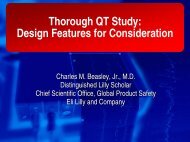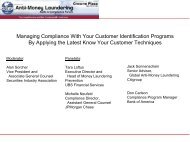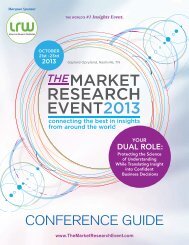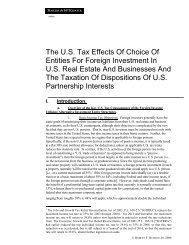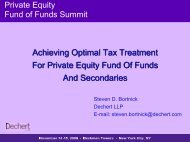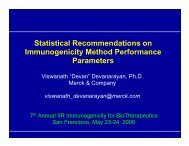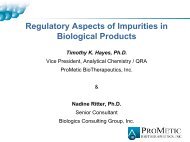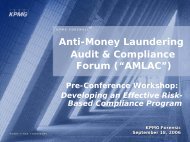The US Tax Effects Of Choice Of Entities For Foreign Investment - IIR
The US Tax Effects Of Choice Of Entities For Foreign Investment - IIR
The US Tax Effects Of Choice Of Entities For Foreign Investment - IIR
Create successful ePaper yourself
Turn your PDF publications into a flip-book with our unique Google optimized e-Paper software.
the partnership's assets equals 75% of its total share of the partnership's gain (i.e.,<br />
75,000/100,000), the portion of FP l's gain from the disposition of its partnership interest that is<br />
attributable to ECI property of the partnership equals $75,000 (75% of the $100,000 gain on<br />
sale). This gain is treated as ECI gain (U.S. source) subject to U.S. tax. In applying the above<br />
rules, a foreign partner's gain on the disposition of an interest in a partnership that is engaged in<br />
a U.S. trade or business is presumed to be U.S. source ECI gain in its entirety 55 .<br />
In situation 3, the IRS applied the above aggregate approach in a situation where the tax<br />
consequences of the foreign partner are subject to a treaty whose provisions are identical to<br />
those of the Draft United States Model Income <strong>Tax</strong> Treaty (June 16, 1981) (the Treaty). FP2, an<br />
alien individual resident in Country Y, is a partner in partnership PS2. PS2 has a permanent<br />
establishment in the United States within the meaning of the Treaty. <strong>The</strong> assets of PS2 consist<br />
of immovable and movable property located in Country Y, and movable property located in the<br />
United States that are assets of the permanent establishment. Under the Treaty, gain from the<br />
disposition of movable property by the U.S. treaty partner is generally exempt, except that such<br />
gain is generally taxable if from the alienation of movable property that are assets of a<br />
permanent establishment in the United States; FP2 disposes of the partnership interest.<br />
<strong>The</strong> IRS, noting that: (1) the partnership's permanent establishment is imputed to its partners 56 ;<br />
and (2) the determination of whether gain from the alienation of movable property is<br />
attributable to a permanent establishment in the United States is generally made by applying<br />
analogous principles to those applied to determine whether an item is effectively connected<br />
with the conduct of a trade or business within the United States, ruled that to the extent the<br />
partner's potential distributive share of unrealized gain of the partnership is attributable to the<br />
partnership's United States permanent establishment, such gain is taxable under the Treaty.<br />
c. Criticism of IRS aggregation theory.<br />
When a partnership is engaged in operations both within and without the United States, taxation<br />
of a foreign partner on the full amount of the gain realized on the sale of its partnership interest<br />
improperly subjects the foreign taxpayer to U.S. tax on foreign source income earned outside<br />
the United States. By the same reasoning, treatment of the full amount of the gain in the above<br />
situation as foreign source, non-ECI gain improperly permits the foreign partner to escape U.S.<br />
tax on gain that is related to business operations of the partnership carried on in the United<br />
States. <strong>The</strong> aggregate approach adopted by the IRS solves this dilemma by taxing the foreign<br />
partner on gain on sale of its partnership interest, but only to the extent such gain is attributable<br />
to the partnership's business activities in the United States.<br />
Although the IRS's position in Rev. Rul. 91-32 may be defensible from a tax policy standpoint,<br />
the IRS's interpretation of the Code and Regulations advanced in support of this result is<br />
without merit. As noted above, the IRS reaches two independent conclusions in Rev. Rul. 91-<br />
32: (1) that in applying the general entity rule of Code §741, a foreign partner's gain on the sale<br />
of its interest in a partnership that is engaged in a U.S. trade or business through a fixed place of<br />
business in the United States is effectively connected (U.S. source) gain, and (2) that in view of<br />
the possibility of improperly taxing a foreign partner on gain on sale of its interest due to<br />
appreciated foreign source property, an aggregate mechanism should be applied for purposes of<br />
55 Rev. Rul. 91-32 indicates that for purposes of applying the above test, the ECI (U.S. source)<br />
property of the partnership does not include U.S. real property interests held by the partnership.<br />
§897(g) governs the treatment of amounts on sale that are attributable to U.S. real property interests<br />
held by the partnership, and applies before the ruling test is applied.<br />
56 See: Unger v. Comr., T.C. Memo 1990-15, aff'd, 936 F.2d 1316 (D.C. Cir. 1991), citing Donroy,<br />
Ltd. v. U.S., 301 F.2d 200 (9th Cir. 1962). In Unger, the Court held that a Canadian national with an<br />
interest in a U.S. limited partnership was attributed the U.S. permanent establishment of the <strong>US</strong>LP<br />
for purposes of the U.S. -Canada Income <strong>Tax</strong> Convention. Accordingly, the Court held that the<br />
taxpayer was subject to U.S. taxes under the Treaty on his share of the <strong>US</strong>LP’s capital gains.<br />
14



